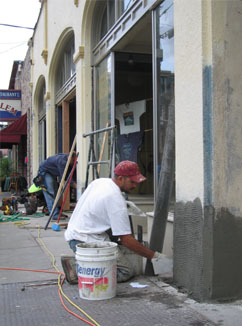General Preservation Guidance
Secretary of the Interiors Standards for the Treatment of Historic Properties
 The Secretary of the Interiors Standards is the guiding document to which all preservation projects follow. The Standards are neither technical nor prescriptive, but are intended to promote responsible preservation practices that help protect our Nation's irreplaceable cultural resources. For example, they cannot, in and of themselves, be used to make essential decisions about which features of the historic building should be saved and which can be changed. But once a treatment is selected, the Standards provide philosophical consistency to the work. The four treatment approaches are Preservation, Rehabilitation, Restoration, and Reconstruction.
The Secretary of the Interiors Standards is the guiding document to which all preservation projects follow. The Standards are neither technical nor prescriptive, but are intended to promote responsible preservation practices that help protect our Nation's irreplaceable cultural resources. For example, they cannot, in and of themselves, be used to make essential decisions about which features of the historic building should be saved and which can be changed. But once a treatment is selected, the Standards provide philosophical consistency to the work. The four treatment approaches are Preservation, Rehabilitation, Restoration, and Reconstruction.
Preservation Briefs
The first Preservation Brief was published in 1975. Since then, over 40 more have been added to the series. Each Brief offers specific advice and background information on how to rehabilitate and restore your historic structure. The Briefs cover items such as how to repair wooden windows, appropriate roofing, exterior paint problems and how to rehabilitate a historic storefront. each brief is available on-line. If you would prefer, the Department of Archaeology & Historic Preservation has a limited number of hard copies of the various briefs.
APT Practice Points
The Association for Preservation Technology (APT) is a U.S. based non-profit organization dedicated to technical historic preservation issues. Their publicly accessible Practice Point series address common preservation construction issues such as material analysis, building systems evaluation techniques, mortar analysis, existing building codes, and many other topics.
Preservation Tech Notes
Initiated in 1984 by the NPS, the Preservation Tech Notes series provides practical information on traditional practices and innovative techniques for successfully maintaining and preserving cultural resources. With over 45 Tech Notes published by Technical Preservation Services, this publication series provides a wealth of information for practitioners in the preservation field, including architects, contractors, and maintenance personnel, as well as for owners and developers of historic properties.
The Tech Notes are organized by categories such as windows, doors, finishes, masonry, mechanical systems, metals, museum collections, site, temporary protection and historic glass.
All Wet & How to Prevent It.. Managing Moisture in your Historic Home
Water, water everywhere! Without argument, it's essential to us. But in terms of the places where we live or work, unwanted moisture means erosion, corrosion and rot! This mini-web class can help anyone who cares for, or about , a historic house to better understand and deal with the three most common sources of the "wet stuff."
From the Roof Down... and Skin Deep. What your historic house really wants from you!
This simple on-line long distance learning tool will guide you through the basics of historic preservation. This a easy to use on-line guide for the historic home owner.
The "Whole Building" Design Approach
The goal of 'Whole Building' Design is to create a successful high-performance building. To achieve that goal, we must apply the integrated design approach to the project during the planning and programming phases. It is necessary for the people involved in the building design to interact closely throughout the design process. The owner, building occupants, and operation and maintenance personnel should be involved to capture their understanding of how the building and its systems will work for them once they occupy it. The fundamental challenge of 'whole buildings' design is to understand that all building systems are interdependent.
Rebuilding Community
A Best Practices Toolkit for Historic Preservation and Redevelopment by the National Trust for Historic Preservation




